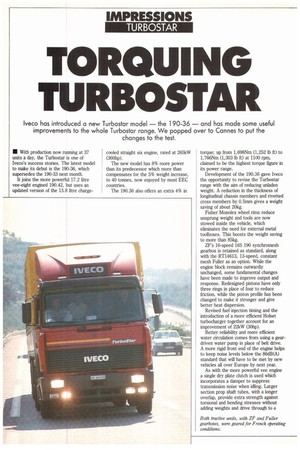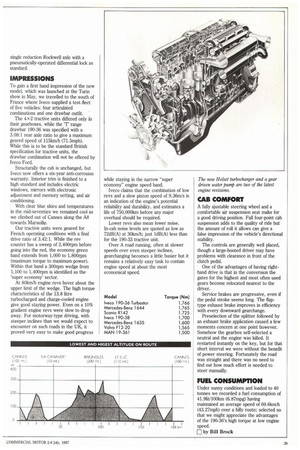TORQUING TURBOSTAR
Page 40

Page 41

If you've noticed an error in this article please click here to report it so we can fix it.
lveco has introduced a new Turbostar model — the 190-36 — and has made some useful improvements to the whole Turbostar range. We popped over to Cannes to put the changes to the test.
• With production now running at 37 units a day, the Turbostar is one of lveco's success stories. The latest model to make its debut is the 190-36, which supersedes the 190-33 next month.
It joins the more powerful 17.2 litre vee-eight engined 190.42, but uses an updated version of the 13.8 litre charge
cooled straight six engine, rated at 2651W (360hp).
The new model has 8% more power than its predecessor which more than compensates for the 5% weight increase, to 40 tonnes, now enjoyed by most EEC countries.
The 190.36 also offers an extra 4% in torque; up from 1,698Nm (1,252 lb ft) to 1,766Nm (1,303 lb ft) at 1100 rpm, claimed to be the highest torque figure in its power range.
Development of the 190.36 gave Iveco the opportunity to revise the Turbostar range with the aim of reducing unladen weight. A reduction in the thickness of longitudinal chassis members and rivetted cross members by 0.5trun gives a weight saving of about 20kg.
Fisher Monolex wheel rims reduce unsprung weight and tools are now stowed inside the vehicle, which eliminates the need for external metal toolboxes. This boosts the weight saving to more than 85kg.
ZF's 16-speed 168 190 synchromesh gearbox is retained as standard, along with the RT14613, I3-speed, constant mesh Fuller as an option. While the engine block remains outwardly unchanged, some fundamental changes have been made to improve output and response. Redesigned pistons have only three rings in place of four to reduce friction, while the piston profile has been changed to make it stronger and give better heat dispersion.
Revised fuel injection timing and the introduction of a more efficient Ho!set turbocharger together account for an improvement of 22kW (30hp).
Better reliability and more efficient water circulation comes from using a geardriven water pump in place of belt drive. A more rigid front end of the engine helps to keep noise levels below the 86dB(A) standard that will have to be met by new vehicles all over Europe by next year.
As with the more powerful vee engine a single dry plate clutch is used which incorporates a damper to suppress transmission noise when idling. Larger section prop shaft tubes, with a longer overlap, provide extra strength against torsional and bending stresses without adding weights and drive through to a
IMPRESSIONS
To gain a first hand impression of the new model, which was launched at the Turin show in May, we travelled to the south of France where Iveco supplied a test-fleet of five vehicles: four articulated combinations and one drawbar outfit.
The 4 x2 tractive units differed only in their gearboxes, while the range drawbar 190-36 was specified with a 3.08:1 rear axle ratio to give a maximum geared speed of 115Iun/h (7I.5mph). While this is to be the standard British specification for tractive units, the drawbar combination will not be offered by Iveco Ford.
Structurally the cab is unchanged, but Iveco now offers a six-year anti-corrosion warranty. Interior trim is finished to a high standard and includes electric windows, mirrors with electronic adjustment and memory setting, and air conditioning.
With clear blue skies and temperatures in the mid-seventies we remained cool as we climbed out of Cannes along the A8 towards Marseille.
Our tractive units were geared for French operating conditions with a final drive ratio of 3.42:1. While the rev counter has a sweep of 2,400rpm before going into the red, the economy green band extends from 1,000 to 1,800rpm (maximum torque to maximum power). Within that band a 300rpm wedge from 1,100 to 1,400rpm is identified as the `super economy' sector.
At 80km/h engine revs hover about the upper limit of the wedge. The high torque characteristics of the 13.8 litre turbocharged and charge-cooled engine give good staying power. Even on a 10% gradient engine revs were slow to drop away. For motorway-type driving, with steeper inclines than we would expect to encounter on such roads in the UK, it proved very easy to make good progress while staying in the narrow "super economy" engine speed band.
Iveco claims that the combination of low revs and a slow piston speed of 9.36m/s is an indication of the engine's potential reliability and durability, and estimates a life of 750,000km before any major overhaul should be required.
Lower revs also mean lower noise. In-cab noise levels are quoted as low as 72dB(A) at 30Icrn/h; just ldB(A) less than for the 190-33 tractive unit.
Over A road running, often at slower speeds over even steeper inclines, gearchanging becomes a little busier but it remains a relatively easy task to contain engine speed at about the most economical speed. The new Holset turbocharger and a gear driven water pump are two of the latest engine revisions.
CAB COMFORT
A fully ajustable steering wheel and a comfortable air suspension seat make for a good driving position. Full four-point cab suspension adds to the quality of ride but the amount of roll it allows can give a false impression of the vehicle's directional stability.
The controls are generally well placed, though a large-booted driver may have problems with clearance in front of the clutch pedal.
One of the advantages of having righthand drive is that in the conversion the gates for the highest and most often used gears become relocated nearest to the driver.
Service brakes are progressive, even if the pedal stroke seems long. The flaptype exhaust brake improves in efficiency with every downward gearchange.
Preselection of the splitter followed by an exhaust brake application caused a few moments concern at one point however. Somehow the gearbox self-selected a neutral and the engine was killed. It restarted instantly on the key, but for that short interval we were without the benefit of power steering. Fortunately the road was straight and there was no need to find out how much effort is needed to steer manually.
FUEL CONSUMPTION
Under sunny conditions and loaded to 40 tonnes we recorded a fuel consumption of 41.91it/100km (6.87mpg) having maintained an average speed of 69.6km/h (43.27mph) over a hilly route; selected so that we might appreciate the advantages of the 190-36's high torque at low engine speed.
by Bill Brock




















































































